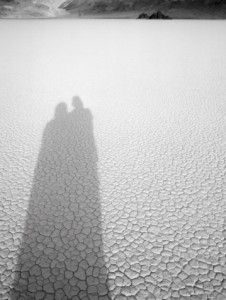Clothed in Clarity, Veiled in Light (Part 1)
By Asher Crispe: May 23, 2012: Category Decoding the Tradition, Inspirations
Approaching Modesty and Mystery in Kabbalah, Philosophy and Science
just knowing each other
with eyes closed (1)
Octavio Paz
—you fall from your body to your shadow not there but in my eyes
in a motionless falling of waterfall sky and earth joining
you fall from your shadow to your name untouchable horizon
you drop through your likenesses I am your remoteness
you fall from your name to your body the furthest point of seeing
in a present that never ends the imaginings of sand…(2)
Octavio Paz
Re/verses: The Poverty of the Concept of Modesty
הִגִּיד לְךָ אָדָם מַה טּוֹב וּמָה יְהֹוָה דּוֹרֵשׁ מִמְּךָ כִּי אִם עֲשׂוֹת מִשְׁפָּט וְאַהֲבַת חֶסֶד וְהַצְנֵעַ לֶכֶת עִם אֱלֹהֶיךָ:
מיכה ו:ח (3)
בָּא זָדוֹן וַיָּבֹא קָלוֹן וְאֶת צְנוּעִים חָכְמָה:
משלי אי:ב (4)
Tackling the meaning of modesty or tzniut in Judaism is a subject for a book-length treatment. Yet, this phenomenon has been the focus of a number of recent studies that have yielded significant philosophic structures and underscored scholarly neglect, particularly in the realm of understanding the esoteric side of this topic. Many people have a common web of associations that place modesty as a form of conduct, a manner of dress, or a statement of humility squarely within the historical social norms and moral teachings that embody Jewish law and custom.
By situating various maxims about modesty against the backdrop of social behavior and relegating their meaning to a form of socio-psychological preference, utility, or reverence for and before the human and the Divine, the finer structures and issues at large are dissolved into questions of the bottom line sexual politics and power-plays that dissimulate the goal of protecting privacy amidst peaceful intersubjective co-existence. Does one consent to hide oneself or is one coerced? While the weight given to these historical questions is more than justified and certainly not without application to the religious, political, and educational realms of today, we might entertain the notion that buried beneath it all lies the unrealized or unvocalized workings of a number of higher order philosophic concepts.
The present essay is an inquiry into the nature of these concepts in an attempt to gather many dispersed particles on the matter and demonstrate the effects of reading them together as an interpreted cluster. I would submit that this chain of concepts links the idea of modesty to that of unknowability—to the mystery and infinition of the self which emerges out the depths of Jewish mystical intuitions.
A musing over modesty might be inclined to obsess about appearances. Considerations of Self-image, being in the public eye, overexposure vs. keeping a low profile, avoiding detection, and the quest for invisibility, all fall short of the primary sense of the Hebrew word tzniut. Even the word for modesty is modest! Used a mere two times in the entire Hebraic Bible as the first strata from which to cultivate the meaning of the word, we find a strange focus on ‘dynamics’ in the bequest to “to walk humbly (modestly)” [Micah 6:8] with God and secondly, to achieve “intuitions” for with “the modest ones (comes) wisdom” [Proverbs 11:2].
Our first example underscores the requirement of ‘walking’ i.e. moving in a stealth manner. Other examples of covert activity, of arriving on the scene without being announced, of sleight of hand moving quicker than the eye, all illustrate the clandestine interactions accomplished without calling attention to self. Yet, beyond the advocacy of being discrete, modesty in our second verse accesses wisdom and insight bestowing discretion. We might say that the upside of photophobia is clairvoyance such that only wisdom or in-sight can offer. (5)
What is gained in rendering tzniut as modesty? This translation must have a payoff. A quick survey of western thought produces the following definition of modesty from the writings of Augustine: “The word modestia (moderation) is derived from modus (measure), and the word temperantia (restraint from temperies [proper mixture, limit]).”(6)
The measure and limit or rather de-limited and restraining process of self-contraction and withdrawal from perceptual view is another facet of the term tzniut, which we will encounter later with the intersecting discussions of Levinasian modesty (with all their kabbalistic import)(7) and the unique treatment of the Elijah ben Solomon Zalman, the Gaon of Vilna, in his extensive commentary on the sifra di-zeni‘uta (literally the book of modesty/concealment) section of the Zohar.(8)
Part and parcel with this later discussion we will draw upon the observation of Elliot Wolfson who, in his analysis of this difficult piece of the Gaon of Vilna, highlights “…the conceptual underpinning of the link that he makes between modesty and mystery: the concealment (zeni‘uta) may be revealed only to the humble (zenu‘in).”(9)
Thus far we have encountered none of the familiar references to corporeal modesty. Moreover, as traditions exoteric and esoteric, philosophical, and mystical have shown, the emphasis on the modest body or the body to be concealed, places more weight on the female body. Not that the male body is excluded by any means, but rather we find a marked asymmetry between the genders. (10)
Here we meet at the crossroads of multiple western traditions, the identification of the male-female dynamic with that of the body and soul. The Zohar succinctly states the phenomenon in that the “women is the body,”(11) wherein all females in the various texts quoted in the Zohar may be suspected if not explicitly stated to be standing in for the body or the “body-complex”.(12)
 Therefore, we will need to address the tension between understanding all human subjects as relatively ‘male’ souls contained in relatively female ‘bodies’ and the more problematic assignment of all the qualities of the body to the female—where women might be reduced to the role of the body. In other words, how metaphoric or how literal are we to take this?
Therefore, we will need to address the tension between understanding all human subjects as relatively ‘male’ souls contained in relatively female ‘bodies’ and the more problematic assignment of all the qualities of the body to the female—where women might be reduced to the role of the body. In other words, how metaphoric or how literal are we to take this?
The problematizing of the body has a long history in both philosophy and religion. One might ask: is the human subject known exclusively through the body? Are we reducible to our corporeal appearances? What sort of knowledge is this? If not for the body would we ever be seen? If not for the body would we ever find a place to hide and remain hidden? This work may be ever yet to come.
1 From “With Eyes Closed”: Collected Poems of Octavio Paz p.271.
2 From “Blanco”: Collected Poems p.325.
3 Micah 6:8.
4 Proverbs 11:2.
5 Comparing wisdom to sight especially insight can be found in a number of classical Talmudic statements. Take for example: “Who is wise? One who sees that which is being born.” Tamid 32a.
6 De Beau Vita. Translated by Ludwig Schopp (St.Louis: Herder, 1939), p.124 as quoted in Levin, Gestures of Ethical Life, p.358.
7 Particularly with regard to his philosophic translations of the Nefesh HaChaim as noted by Wolfson and others, Levinas modifies what appears to be the purely functional characteristics of the tzimtzum or Divine contraction, withdrawal and disappearance, to shape the ethical sphere of modesty and its relation to alterity (with emphasis on the feminine). See sections 4 and 5.
8 See Zohar II 176b-179a.
9 “From Sealed Book” in Interpreting Judaism in a Postmodern Age p.157.
10 See Wolfson’s remarks in “Secrecy, Modesty, and the Feminine” p.211 in The Journal of Jewish Thought and Philosophy, vol.14 2006
11 “אשה דא גופא” see Zohar I 181b.
12 Regarding this Zoharic passage Daniel Matt cites in the Zohar (Pritzker Edition) vol.3 p.103 note 120: “Soul and body are symbolized respectively as male and female, a distinction common in Western thought. See Aristotle, Generation of Animals 2:4: ‘While the body is from the female, it is the soul that is made from the male, for the soul is the substance of a particular body.’”
http://www.interinclusion.org/inspirations/clothed-in-clarity-veiled-in-light-part-2/
























;)
;)
;)
;)
;)
;)
;)
;)
;)
;)
